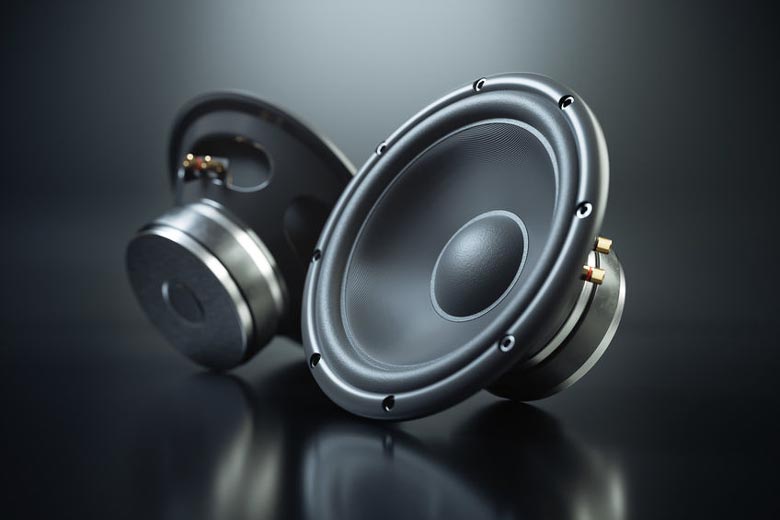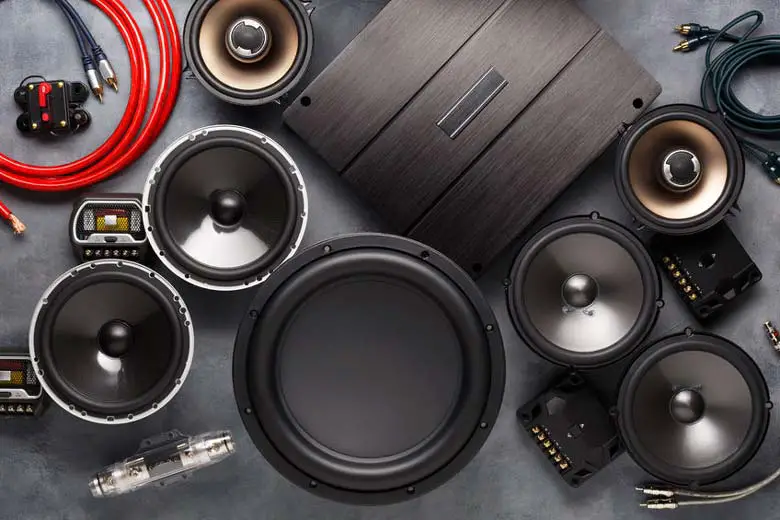Car speakers, like other speakers, have magnets in them. To be more precise, most car speakers have two magnets; a permanent magnet and an electromagnet. But why do car speakers have magnets in them, and what do they do?
Car speakers have magnets in them to produce sound. Magnets inside car speakers transform an audio signal carried by an electric signal into mechanical vibrations as the signal cuts through the magnetic field. These mechanical vibrations from the speakers are what our ears perceive as sound.
The relationship between magnets and sound is an exciting topic you don’t want to miss. In this article, I will explain why car speakers have magnets in them, what they’re made of, and answer other interesting questions you may have.

How Magnets Produce Sound in Car Speakers
Before I go any deeper, let’s go over a few facts to better understand how magnets produce sound:
- Magnets have two poles (North and South), which create a strong magnetic field around them.
- Opposite poles attract, similar poles repel.
- A magnetic field is an invisible force that varies by the strength, type, and size of the magnet.
- The electromagnet is attached to the speaker cone (diaphragm).
- The electromagnet is made of several rounds of wire connected by two leads.
When electric current flows through the metal coil, it creates a temporary magnetic field. The interaction between the permanent and temporary magnetic fields makes an audible sound.
There are several ways to create sound with magnets. The conventional method is through a loudspeaker containing a metal coil and a fixed magnet.
When an electric current flows through the loop, it creates a magnetic field that interacts with the permanent magnet in the car’s speaker. Changes in the electromagnet’s polarity cause vibration as the electromagnet gets pulled and pushed away from the permanent magnet.
Here’s a great video showing you how it works:
Car speakers also comprise two magnets and a cone made of plastic or paper. The electromagnet is mounted on the plastic/paper cone, and the permanent magnet goes at the back of the setup.
Every time an electric current flows through the electromagnet, it becomes magnetized, making it behave like an ordinary magnet.
The North pole of the permanent magnet attracts the South pole of the electromagnet, whereas the South pole of the permanent magnet repels the South pole of the electromagnet. As the current passes through the setup, the electromagnet’s polarity changes.
Since the electromagnet is attached to the speaker cone, any movement shifts onto the cone as well. The cone bumps into the nearby air molecules, which also vibrate to produce soundwaves.
Can a Car Speaker Work Without a Magnet?
You can build many different types of speakers using various kinds of magnets. The bigger and more powerful the magnet, the louder the speaker. That’s why your subwoofer sounds produce louder bass than your tweeters (it’s all in the size of the magnet).
Not all speakers have a permanent magnet, though. Permanent magnets are heavy and take up more space, while lighter electromagnets consume little space. Very lightweight speakers are made using two electromagnets. Your car likely has a combination of these two types of speakers.
One electromagnet stays in a fixed position, just like a permanent magnet. The other electromagnet is attached to the cone and is moveable.
A car speaker can work without a magnet. However, a magnetic car speaker cannot work without a magnet. Magnetic car speakers use two magnets to create opposing magnetic fields. The magnet attached to the cone can vibrate as its polarity changes while in the magnetic field of the second magnet.

Today, we have plasma speakers, piezoelectric speakers, and electrostatic speakers, all building their reputation in the audio industry.
But good luck making magnetic speakers work without a magnet. Magnetic speakers are the most popular type of speakers in almost all car sound systems.
Why Do Car Speakers Have Two Magnets?
So, we’ve seen that magnetic speakers cannot work without a magnet. That brings us to the question of whether one speaker will be enough to get the job done. As you may have noticed, speakers have two magnets in them.
Car Speakers have two magnets to create different opposing magnetic fields. The permanent magnet already has a magnetic field surrounding it, while the electromagnet relies on the flow of current.
Electrical energy is converted to magnetic energy. The speaker cone picks it up from here and converts the magnetic energy into mechanical energy, which gets to our eardrums.
There are different materials used to make car speaker magnets. The most popular choices include the following:
- Alnico. It is known for producing more classic tones. It works well on lower volumes and makes them sound warmer and sweeter. It’s more expensive as it is tougher and less prone to cracking. One of their drawbacks is that they tend to lose magnetism over time.
- Neodymium. It is also a popular magnetic material. It’s durable and makes the strongest magnets with the strongest fields when used as a permanent magnet. Neodymium is a little bit more expensive than alnico and ceramic. But, what would you expect from a material that forms smaller, lightweight, but incredibly strong magnets?
- Ceramic magnets (also known as Ferrite magnets). It builds speakers with great sound at higher volumes. Ferrite magnets cost less but crack more quickly than neodymium and alnico magnets. They’re also pretty heavy, which matters a lot with car speakers.
Why Are Magnets in Car Speakers Round?
One last thing; if you look closely, most car speakers are round in shape. In fact, most speakers have a round shape except the 6x9s, which are oval. It all boils down to the size of the speaker. Large and small speakers have different properties.
For instance, big speakers sound better than small speakers. Larger speakers have bigger magnets, meaning they have a larger driving force than the smaller ones — the bigger the magnet, the larger the opposing magnetic field, and the better the sound.
Magnets in car speakers are round to accommodate larger North and South poles. The round shape has a larger surface area. Circular magnets have a larger cross-sectional area than other shapes. They cover a larger surface area, which increases the strength of the opposing magnetic field.
Round magnets provide better sound quality than square or rectangular magnets. The magnet’s round shape helps create a consistent field that won’t distort the sound. Square and rectangular magnets may distort the sound because their fields aren’t uniform.
Bar magnets are rectangular; their poles (North and South) sit at each end of the bar. Round magnets are circular. Their poles are located on each side of the magnet. Bar magnets are considered weaker than other magnets due to the distribution of the magnetic fields across smaller surface poles located only at the tips.
On the other hand, round magnets have larger round poles. This means that the magnetic fields of circular magnets are distributed on the larger circular poles.
So, if you’re looking for the best possible sound from your car speakers, make sure to use round magnets.
Final Thoughts
Magnets are an essential part of car speakers, both small and large. They create opposing magnetic fields that create vibrations, which the cone turns into sound. So, the larger the magnet, the stronger these electromagnetic forces will get when creating louder sounds with deeper bass frequencies as if there wasn’t anything holding them back.
Your car likely has a system of different speakers; some might have one electromagnet combined with a permanent one, others may have two electromagnets. You can tell that a speaker has two electromagnets if they’re only magnetic when the speakers are on.